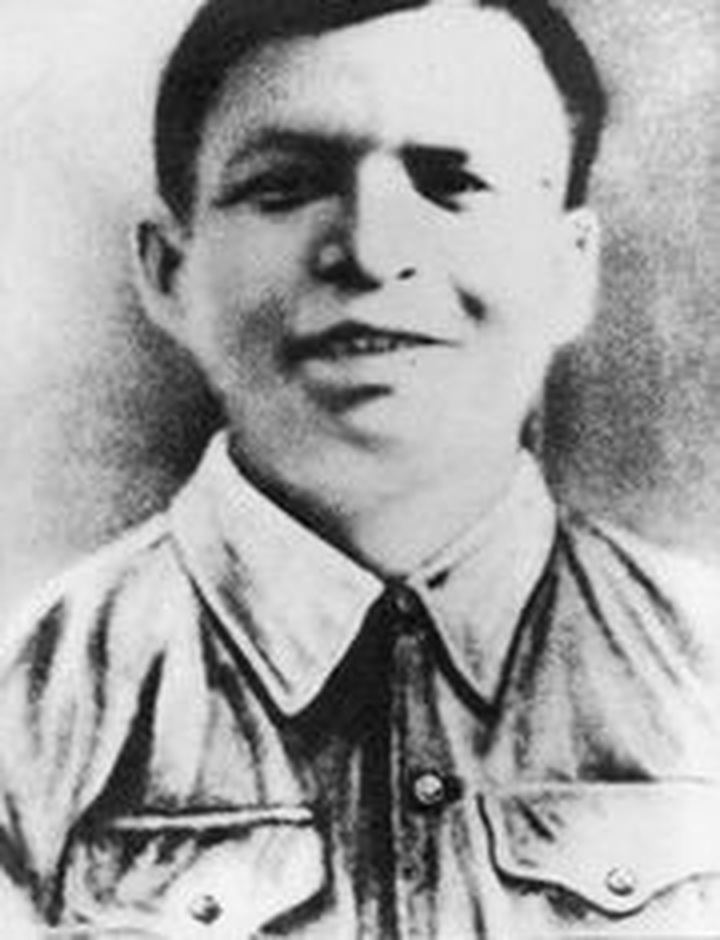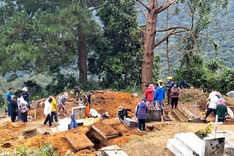General Vo Nguyen Giap had chosen the mountain of Muong Phang to set up his headquarters. It was 17 kilometers east of Dien Bien Phu. The landscape surrounding this hideout was charming and peaceful. From this location, Giap could see clearly in the distance the entire Dien Bien Phu battlefield, day or night. He had to spend a great deal of time working with his subordinates and the setting had become his home away from home.

Viet Minh soldiers in a trench at DBP
Since Giap greatly enjoyed music and folk songs, an outdoor concert was held at the mountain site regularly. Member of his staff would bring their musical instruments and they would play and sing revolutionary songs. Giap was deeply moved by the heart-rending songs composed by his own troops. Among the most popular ones were “Qua miền Tây Bắc” (Crossing the northwest region), “Hành quân xa” (Being away at the battlefield) and “Núi Nhị Lang”(The mountain of Nhi Lang). When the timing of the battle of Dien Bien Phu was approaching, there was the high risk of being discovered by the enemy. Each musical event would take place inside the dugout below Giap’s thatch hut.
Before sunrise on March 13, the interior of Giap’s dugout was brightly lit. On his desk, a large map of the battlefield was spread out. Giap was holding a pencil and tracing various points on the map. Sometimes he got up and walked around the room. Sometimes his eyes were glued to the map. He checked and tested the phone lines, and he talked to the Communication team. Everyone looked calm and confident. But the Commander himself showed some anxiety. Giap was concerned about one of his regiments being attacked by a brigade of the Foreign Legion while crossing the Nam Rom River in the night.
A few Dakota warplanes were circulating above the forest paths surrounding the wok-shaped valley. Suspecting some Viet Minh troop movements, they shot wildly into the forests and the Viet Minh’s trenches. The day before, they had discovered a section of the trenches and some Vietnamese soldiers and civilians were killed and injured during that attack.
The Viet Minh’s artillery force consisted mainly of young soldiers in their late teens and early 20’s. They had volunteered for the army some years earlier and had gained experience in combat. On the mountain ridges, before the battle, they were given three extra hours of sleep. Emerging from the trenches, they were still covered with mud from head to toes. On their first day of artillery duty, they were given hot water and shampoo for a thorough cleaning. The entire artillery team was dressed in new jungle green uniform, neatly pressed and scented. Each person rolled his or her shirt sleeves up to the elbows, with belt tightened around the waist. Their meals that day included steamed glutinous rice in banana leaves, charcoal grilled meat, and boiled sugar cane water. To prevent any health crisis, raw vegetables or fruits would not be allowed.
Standing by howitzers overlooking the deep valley, at 8 am they began sporadic shelling of Muong Thanh airfield. Two planes circulating around the edges of the forest were shot down. At 10:30 a third plane sitting at the airfield was hit by a mortar and broke in half.
From 1:30pm, the Viet Minh began shelling the center of French resistance, known to the Vietnamese as Him Lam and to the French as Beatrice. The volume and intensity of firing would increase by the hour. Overlooking a village below with the northwest mountain range behind, Him Lam consisted of three forested hills. The four strongpoints in this cluster were named by General De Castries Beatrice 1, 2, 3, and 4.
Approaching 5 pm, it was completely silent inside the Viet Minh’s headquarters. Then all of a sudden, Giap grabbed the radio phone and rushed to the entrance of the bamboo hut. His voice was sharp and clear, “Artillery! Be ready!” At 5 pm, Giap was unusually calm while looking at his watch. He ordered the entire artillery force of 40 howitzers to open fire at Him Lam. The Foreign Legion commander of this outpost, Paul Pergot, and all his staff were killed by a direct hit on their bunker. A few minutes after, Colonel Jules Gaucher, commander of the entire French northern section was also killed.
At Muong Thanh airfield, the engines of seven warplanes started roaring, with the pilots attempting to escape. But it was too late. One plane was hit and turned into a giant fireball. The remaining six planes remained at a standstill.
 |
| Phan Dinh Giot (1922-1954) |
On the Viet Minh side, there was the heroic death of Phan Dinh Giot, head of a Section in Battalion 428. Giot had been known for his endurance of physical hardship and steely mental strength. During the afternoon of March 13, his Section tried to break into the second strongpoint of Him Lam with guns and grenades. Giot was wounded in the leg by enemy fire. Several of his comrades were killed and wounded.
Despite the pain and bleeding, Giot was still determined to fight on. Using all his strength, he threw the tenth grenade at the blockhouse of the third strongpoint. The enemy retaliated with a massive volume of gunfire. His Section was running out of bullets and grenades. Everyone was in despair. Giot leaped over and used his own body to block the fire from the blockhouse’s rifle pit. His body completely covered the gun port, glued itself to the exterior wall, blocking the enemy’s fire. This enabled his comrades to quickly advance toward the third outpost. Giot shouted out his last words, “Sacrificing for my people”. Inspired by his action, remaining members of his Section started hand-to-hand fighting with French troops.
At 10:30 pm, both strongpoints, Beatrice 1 and 3, fell under the Viet Minh control. Beatrice 2 and 4 fell a few hours later.
The next morning, while the French commanders were discussing their strategy for retaliation, a distressed Foreign Legion officer, whose body was covered with blood and bandages, appeared before them. He delivered a letter to De Castries from the Viet Minh. Colonel Mac Ninh, new commander of Him Lam, had instructed De Castries to remove the casualties by ambulances from 8 am to midday.
A surviving soldier of this Operation Vulture, Sgt. Stefan Kubiak, described the destruction of Him Lam (Beatrice):
“I thought the world was ending. Beatrice blew up and melted in smoke. The earth around me was violently shaken. Many members of our Foreign Legion fell to their knees. Dead and wounded bodies were scattered all over the place. We were in a state of deep shock. We asked ourselves how the Viets had been able to find so many cannons capable of producing artillery fire of such power. Shells rained down on us without stopping like a sudden hailstorm on an autumn evening. Bunker after bunker, trench after trench, collapsed, and buried under them men and their weapons.”
For members of Division 312, there was no time to mourn the loss of Phan Dinh Giot, who would later be honored as a national hero. Following their first victory, a member of the Division composed “The Cannon Song” (Bài Ca Pháo Kích). This is part of the song:
Our cannons, iron legs and steel shouldersOur soldiers are good fighters and precision marksmen
Our gun barrels can reach everywhere
Our base is here, land and territory
Saving the nation, honoring our revolutionary tradition
Shoot! Shoot! Shoot!
Series of firing are series of thunderclaps
Each bullet contains profound anger and hatred
We are going through all the terrains
Together with our people, we will march toward the great victory.

The author at Phan Dinh Giot’s tomb



















